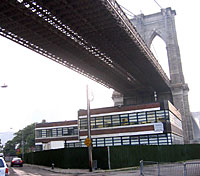An historic building proposed for demolition by designers of Brooklyn
Bridge Park, a 1.3-mile open space, housing and commercial development
along the waterfront, has split supporters of the plan and even preservation
agencies at the city and state level.
Built in 1936 as a project of the Works Progress Administration, the Purchase
Building, located under the Brooklyn Bridge overpass off Old Fulton and
Water streets in Fulton Ferry, features late-art deco and early modernist
designs.
According to the Environmental Impact Statement (EIS) released last week
by the state-run Brooklyn Bridge Park Development Corporation, the warehouse,
a mix of brick and thin glass-window facing with pink-toned concrete ribbons,
is useless to an 80-acre open space of green, water and revenue-generating
developments that will form Brooklyn Bridge Park. Additionally, the EIS
says the building will split the park in two, destroying view planes.
“The park plan calls for the removal of the Purchase Building, currently
located under the Brooklyn Bridge,” states the document, calling
the demolition “critical for connecting the northern and southern
parts of the park” and “providing magnificent views of the Manhattan
skyline from both north and south.”
To the mind of the park planners, the building divides two segments of
the park — the somewhat-complete Empire-Fulton Ferry State Park portion,
where the Brooklyn Bridge Park Conservancy hosts events throughout the
year, from the commercial cluster of activity leading to the yet-unformed
portion of the park: Piers 1 through 6.
For historians and artists, the building represents a step in architectural
design that married art deco and modernism.
Wendy Gibson, a spokeswoman with the State Historic Preservation Office
(SHPO), said that while the building was in an historic district, the
Purchase Building was considered “non-contributing.”
“The building is in the [Fulton Ferry] National Historic District,
but we considered it a non-contributing building because it wasn’t
built during the historic period of significance of the district,”
Gibson said, adding that even if it were declared a city landmark, she
didn’t believe the designation would supercede the state authority
to build the park, even though the land it suits on is city-owned.
The city disagreed.
On Sept. 6, 2001, the city Landmarks Preservation Commission held hearings
after a request by the Department of Parks and Recreation calling for
a review of the building’s significance to the Fulton Ferry Historic
District, a city landmark district of which it is a part. Review of the
building’s significance fell by the wayside after 9-11.
Landmarks Preservation Commission sources said this week that no action
could be taken against the Purchase Building until the case was reopened.
If it was determined that the Purchase Building either fit in as part
of the historic district or held its own role in architectural history,
warranting an individual landmark designation, then the building could
not be torn down.
Judy Stanton, executive director of the Brooklyn Heights Association,
said many people assumed the building was safe.
“Any contributing building in a landmark district is protected. And
the law prohibits their demolition,” she said.
“When you go down what we think is a very dangerous slope of demolishing
buildings, where would that end? And this is for a view. The overall park
is for public purpose, public benefit. We don’t need to knock down
this building, to build new buildings,” said Stanton.
The park proposes the creation of six new revenue-generating buildings,
so it can pay its own operating costs. Five of the buildings will be luxury
condominiums and a hotel, combining to create 1,200 new apartments inside
the footprint of the park.
Another building, a restaurant, is planned for the water’s edge on
Pier 1, and indefinite plans for a recreational facility on Pier 5 are
being considered that would not produce substantial revenue.
Nicholas Evans-Cato, a landscape artist who has advocated for adaptive
reuse of the Purchase Building as a park attraction since the late 1990s,
when then-Mayor Rudolph Giuliani announced the building’s possible
demolition, said the demolition makes no sense.
“It’s right at the fulcrum of the park, right where’s there’s
a bend in the river — it’s the shame of Brooklyn,” he said
of the park plans. “If you’re standing in DUMBO, you can’t
really see Pier 1 anyway. The whole argument about a view corridor is
indefensible from a good planning perspective.”
Evans-Cato said other obstructions were just as much a problem for the
views, adding, “The River Cafe’s parking lot, that interferes
with the Brooklyn Bridge Park.” He said the waterfront restaurant’s
front garden and parking area, where valets park patrons’ cars, is
actually public property.
“The whole thing is a public space, but no one ever seems to want
to talk about changing that,” he said.
Stanton echoed his feelings, saying that to demolish the Purchase Building
but leave standing the wall dividing the River Cafe’s parking area,
which she agreed was a public space, was an “Emperor’s wearing
no clothes” situation.
“It’s to look at the site with blinders,” Stanton said.
Evans-Cato added, “Letting people up on the second story and the
roof would provide a unique view of the waterfront.”






















